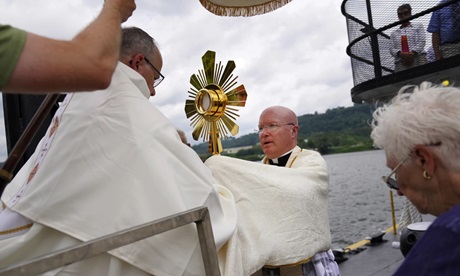When Pope Francis called for a worldwide consultation of lay Catholics about their concerns as part of the Synod on Synodality, U.S. bishops responded less than enthusiastically.
Instead, the U.S. Conference of Catholic Bishops put its time, effort and money into a national programme called the Eucharistic Revival.
Eucharistic Revival
It was not impossible to do both programmes, but as any pastor will tell you, doing two major programmes at once in a parish is very difficult. It is hard enough to do just one program while keeping all the other parish activities rolling along.
With a little bit of effort, the two programmes could have complemented each other instead of being in conflict.
After all, synodality makes for a better Eucharist, and the Eucharist creates and nourishes synodality.
Both are about communion, participation and mission.
“In its broadest sense,” according to the synthesis report from the October 2023 meeting of the synod, “synodality can be understood as Christians walking in communion with Christ toward the Kingdom along with the whole of humanity.”
“Its orientation is towards mission,” says the report, “and its practice involves gathering in assembly at each level of ecclesial life.
It involves reciprocal listening, dialogue, community discernment, and creation of consensus as an expression that renders Christ present in the Holy Spirit, each taking decisions in accordance with their responsibilities.”
Revival is different from synodality
A central part of the parish and diocesan phase of the synodal process is “conversation in the Spirit”.
In this, participants in groups of ten listen to each other about issues facing the Church. The process builds communion and encourages participation in the mission of Jesus.
It is easy to see how this process could translate into participation in the Eucharist, the sacrament of Communion that empowers the Christian community to participate in the mission of Jesus of spreading the good news of the Father’s love and our responsibility to love all our brothers and sisters.
But the Eucharistic Revival has a completely different focus. It is more about Benediction, where the consecrated bread is worshipped, than the Eucharist, where the community is fed.
The impetus for the Eucharistic Revival came from the bishops’ fear that the faithful no longer believe in the real presence in the Eucharist.
In fact, many Catholics do not even understand what the Church teaches about it.
Research findings
According to the Pew Research Center, “More than four-in-ten Catholics in the United States (45 percent) do not know that their Church teaches that the bread and wine used in Communion do not merely symbolise but actually become the body and blood of Christ.”
Pew found that Catholics believed that the bread and wine were only symbols of Christ’s presence.
“Nearly seven-in-ten Catholics (69 percent) say they personally believe that during Catholic Mass, the bread and wine used in Communion ‘are symbols of the body and blood of Jesus Christ,’” according to Pew.
“Just one-third of U.S. Catholics (31 percent) say they believe that ‘during Catholic Mass, the bread and wine actually become the body and blood of Jesus.’”
Others, including the Center for Applied Research in the Apostolate, have challenged Pew’s research.
But Pew’s findings caused a panic among the bishops that resulted in them budgeting $28 million for the Eucharistic Revival, although the budget was later reduced to $14 million.
From its inception, the Eucharistic Revival was about the real presence of Jesus in the Eucharist and the transubstantiation of the bread and wine into the body and blood of Christ.
The revival included Eucharistic processions and Benediction in parishes and dioceses and culminates with a National Eucharistic Congress in Indianapolis from July 17-21, where thousands from all over the country are expected to attend.
But, I repeat, the revival is more about Benediction than the Eucharist.
Benediction is not Eucharist
Benediction is all about worshipping Jesus.
The Eucharist is about worshipping the Father and transforming the community into the Body of Christ. Christ is not made present on the altar table so that we can worship him. He is present so that we can eat him and become what we eat.
The revival focuses on individual rather than community.
It focuses on me and Jesus rather than the communion of Christians. It focuses on what happens to bread and wine rather than what happens to the community. It focuses on personal experience rather than mission.
Let me make clear.
There is nothing wrong with Benediction, but it is not the Eucharist. Jesus did not institute the Eucharist at the Last Supper so that we could worship him. His focus was always on the Father, not himself.
If we listen to the Eucharistic prayer as recited by the priest for the community, we give praise and thanks to the Father for all he has done for us, especially for sending Jesus with the good news of the Father’s love and compassion for us.
We pray not to Jesus but “through him, with him and in him in the unity of the Holy Spirit” to the Father.
We remember Jesus’ life, death and resurrection.
During the Eucharistic prayer we ask for the Spirit to transform us into the body of Christ so that we can continue his mission of bringing justice, peace and love to the world.
Synodality is about communion, participation and mission; so, too, is the Eucharist. Too bad the Eucharistic Revival is not.
- First published in RNS
- The Rev. Thomas J. Reese, a Jesuit priest, is a Senior Analyst at RNS.
News category: Analysis and Comment.




